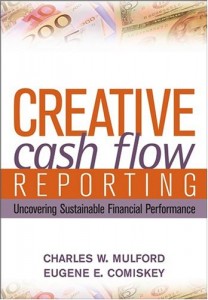Earnings season part 2 – Linn Energy
Linn Energy (LINE), the other company I wanted to discuss, has a more opaque set of figures, and this may be due to the fact that their derivatives strategy is more integral to their business. But on the other hand, Warren Buffett has stated that if a company wants you to understand its financial statements, you will understand them, and if a company doesn’t want you to understand its financial statements, you won’t understand them. I will warn you, the following post is full of accounting.
Chief among my complaints is the fact that their latest 10-Q doesn’t include a three month cash flow statement, requiring you to open last quarter’s 10-Q and subtract. At any rate, their net income is flat at $60 million for the quarter, well under their latest distribution of roughly $80 million, but of course it is cash flow that drives the yield.
 They are kind enough to separate their “core” operations from their derivatives trades, and net income plus depreciation and amortization for the three months did in fact come to about $120 million. From their derivatives activities, they reported $90 million in derivatives profits for the quarter, but only $80 million of that was cash received. As I’ve stated before, they hedge their production several years in advance, so a small movement in oil and gas prices can produce a significant divergence in derivatives income. Actually, the price of oil has certainly been more stable than in 2008 and 2009, but since the prices that Linn Energy locked in for oil is well above the current market price, the large amount of cash from their derivatives is somewhat anomalous, although derivatives income plus sales should not be.
They are kind enough to separate their “core” operations from their derivatives trades, and net income plus depreciation and amortization for the three months did in fact come to about $120 million. From their derivatives activities, they reported $90 million in derivatives profits for the quarter, but only $80 million of that was cash received. As I’ve stated before, they hedge their production several years in advance, so a small movement in oil and gas prices can produce a significant divergence in derivatives income. Actually, the price of oil has certainly been more stable than in 2008 and 2009, but since the prices that Linn Energy locked in for oil is well above the current market price, the large amount of cash from their derivatives is somewhat anomalous, although derivatives income plus sales should not be.
On the next line, they reported a loss of nearly $75 million on cancelled derivatives, which after a little digging in the report I discovered to be $1.2 billion in pay-fixed, receive-floating interest rate swaps. I found this entry curious; the only exposure that Linn Energy had to rising interest rates was on its line of credit, which had an outstanding balance of $900 million at the end of the first quarter and $600 million at the end of the second. Linn Energy had restructured its debt recently to pay for a large acquisition, so clearing out the swaps makes sense, and at any rate I believe that these swaps at the very least are a nonrecurring event.
The final line on the derivatives section of the cash flow statement is premiums paid for derivatives. As I said, Linn Energy engages in careful hedging of the prices of oil and natural gas many years into the future as part of its core strategy, so spending large amounts on derivatives–a total of $91 million year to date–is somewhat to be expected. But Linn Energy spent approximately $90 million on derivatives for the whole of 2009, so although this category may be recurring, the total amount spent by only the second quarter may be anomalously high.
So, where does that leave us in assessing Linn Energy’s sustainable cash flow? First of all, those losses on interest rate swaps are a nonrecurring event, but I also take the position that they are not really an operations expense. As near as I can tell, they were entered into to hedge interest rate exposure on their line of credit, and therefore, they should properly be imputed to the financing cash flows section. As for the derivatives, we might say that since they spent $90 million for all of last year (although previous years involved larger amounts), that the company may have just decided to purchase a year’s worth of derivatives all at once, and if we spread them over a year we find that only $22.5 million should be imputed to this quarter. Taking that into account, we have operating cash flows of $90 million for the quarter, just about enough to cover their distribution. Of course, since the purpose of a company in Linn’s space is to distribute all the cash it can spare, this is not of great concern in terms of coverage.
In fact, we might even be persuaded to take a more generous view of that $90 million in derivatives purchases, since on the next sections of the balance sheet we find that Linn Energy made nearly $600 million in acquisitions for the quarter and nearly $800 million year to date. Obviously, these acquisitions have future production that has to be hedged, so it is likely that some of these hedges are for the future production of the acquisitions, and so there is an argument for classifying the purchases of such derivatives as a use of investing cash flow, thus improving the operating cash flow even further. However, these hedges are part of Linn’s operational strategy, and are intended to reduce their exposure to the price of oil and natural gas rather than speculate on it, and at any rate the amount of the adjustment is difficult to determine, so I think the correct and conservative approach is to leave the derivatives purchase under the operations category and just to make a mental note that things might be better than they appear.
 (If I sound unusually pedantic about the source and allocation of cash flow, it’s because I’ve been reading a book called, funnily enough, Creative Cash Flow Reporting, by Mulford and Comiskey. The title is somewhat misleading, as the authors are very much opposed to creative reporting. But so far it’s a good book and I recommend it).
(If I sound unusually pedantic about the source and allocation of cash flow, it’s because I’ve been reading a book called, funnily enough, Creative Cash Flow Reporting, by Mulford and Comiskey. The title is somewhat misleading, as the authors are very much opposed to creative reporting. But so far it’s a good book and I recommend it).
Turning again to the acquisitions, a typical cash flow watcher would be somewhat concerned that depreciation and amortization year to date have come to less than $125 million, while acquisitions have come to nearly $775 million. Surely, they say, this is a sign of vastly negative free cash flow. Normally they would be correct, but Linn Energy financed these new acquisitions by issuing equity and debt securities rather than reinvested earnings (which is just as well because their policy leaves them no retained earnings to reinvest).
I’m not quite sure how to interpret the debt financing of acquisitions. Based on the $90 million in cash flow from operations I calculated above, their interest is covered three times, which appears safe enough, but there is a wrinkle involved with borrowing against oil fields and other finite assets. When an asset is subject to depletion, it is customary to set aside additional income from the asset in order to pay down principal, because borrowing $700 million on an oil field, extracting ten years’ worth of oil from it, and then expecting to roll over the full $700 million when it falls due, is nothing short of ridiculous. This is why most lenders against such assets require a “sinking fund” provision that requires the borrower to pay down portions of the principal over the life of the loan (generally there is no actual “fund” involved; the company just buys back the bonds according to the agreed-upon schedule, so “fund” is a verb and “sinking” is an adverb). It is curious that Linn Energy’s lenders for this current acquisition did not insist on such a fund. True, they have all of Linn Energy’s assets to sue for, not just the current field, but all of Linn Energy’s properties have the same finite character. Here, Linn Energy will have to decide for itself what amount to set aside for principal, and this amount will definitely have to be higher than nothing.
Now, finding all of this out took a bit of digging through the quarterly report and a number of supplemental 8-K reports, but I think it was worth it to conclude that on a conservative basis, Linn Energy is earnings its distribution and not too much else. Recalling the Warren Buffet quote above, Linn Energy promoted in its announcement of quarterly results, its “adjusted EBITDA,” which is of course, non-GAAP. I’ll never understand why equity investors care about EBITDA, since all of I and all of T are taken out before they see anything, and whatever amount of D and A has to be replaced gets to be replaced by them as well. Even bond investors, for whom EBITDA was originally invented, have to worry about D and A. At any rate, adjusted EBITDA, not surprisingly, was nearly twice my estimate of $90 million in sustainable cash flow for the quarter.
So, where does that leave us from an investing decision standpoint? Linn Energy is earning its distribution, which at 8.4% is both attractive looking and tax-deferred (as with other pass-through tax entities, distributions are not taxed but lower the holder’s basis), and Linn Energy’s hedging strategy mitigates the risk from energy prices. And they are seeing excellent results from their new acquisitions. On the other hand, their current hedges are at a higher-than-market price, and in the next couple of years they step down. Of course, any new acquisitions made by Linn Energy will also be based on the market price, but as it stands I don’t know that I see the possibility of any major improvements in Linn’s position and wouldn’t care to speculate on it, so my basic view is that for Linn’s distribution, what you see is what you get. And if the price goes up much further, what you get isn’t that huge, so I would sell if it goes up much further.
Leave a Reply